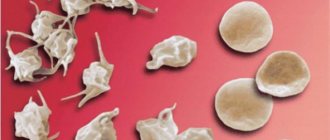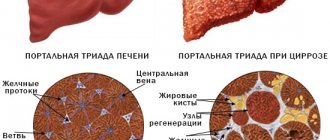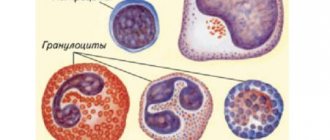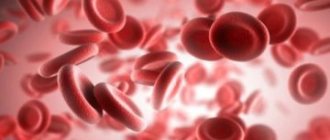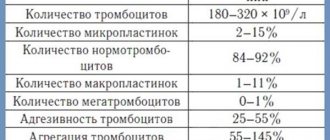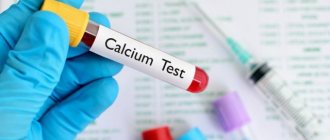The specific chemical smell of children's urine (acetonuria) is a condition that can indicate either a temporary metabolic failure in an absolutely healthy child or a serious chronic disease (diabetes).
However, parents need to remember that this condition, if adequate measures are not taken, can become life-threatening.
Let's try to figure out why the smell of acetone occurs in a child's urine, and what measures should be taken in this case.
How is acetone formed in the body?
When carbohydrates enter the body, they are broken down into glucose and absorbed into the blood in the intestines. One part of the organic compounds is absorbed by cells with the release of energy, and the second is transformed into glycogen and accumulates in the liver tissue. With serious energy consumption - stress, exhausting physical work - glycogen again enters the bloodstream.
In most people, the liver has a high storage capacity, so energy reserves do not run out for a long time. But in 17-20% of young children, the liver tissue accumulates only a small amount of glycogen. And if it is exhausted, lipids (fats) begin to be used as an energy resource. When they are broken down, acetone or ketone bodies appear. If metabolic products are not removed from the blood for a long time, the child’s well-being worsens.
Acetone irritates the vomiting receptors, causing uncontrollable vomiting. Dehydration only aggravates the carbohydrate deficiency, as a result of which the concentration of acetone in the body increases.
Norm of acetone in urine
Ketone bodies are metabolic products that are secreted by the liver tissue. They are involved in metabolism and the release of energy from lipids. These include:
- beta-hydroxybutyric acid;
- acetone;
- acetoacetic acid.
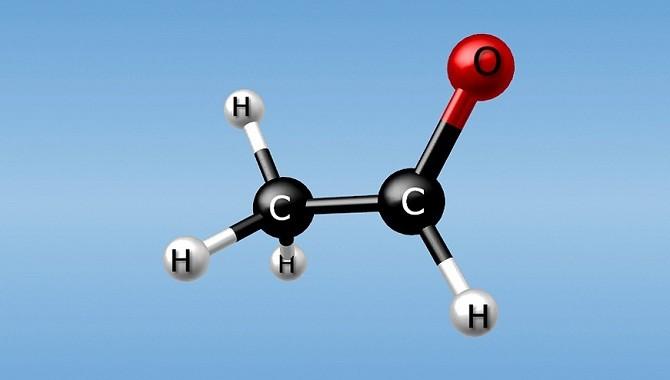
It is formed in the blood in very small quantities. Therefore, during a general urinalysis (UCA), only traces of acetone are detected. Its level in daily urine does not exceed 0.01-0.03 g.
Why does a child's ketone levels increase?
If acetone is detected in a child’s body, this means that the metabolism of amino acids or lipids is impaired. Due to functional immaturity, the gastrointestinal tract malfunctions. With poor nutrition, 5% of children develop metabolic disorders. If a child’s body lacks carbohydrates, lipid metabolism is activated. When fats are broken down, a lot of acetone is formed, which leads to poisoning.
The main reasons for the increase in acetone:
- insufficient intake of glucose from food;
- the predominance of lipids in the diet;
- impaired absorption of carbohydrates in the intestine;
- underfeeding in infants;
- following a strict diet;
- bacterial or inflammatory damage to the gastrointestinal tract;
- dehydration.
An increase in the level of acetone in the urine is accompanied by a violation of water-electrolyte balance and a pathological effect on the gastrointestinal tract and nervous system of the child.
Changes in ketone levels are sometimes a manifestation of disease:
- gastroenteritis;
- hemolytic anemia;
- brain tumors;
- thyrotoxicosis;
- infectious toxicosis;
- Itsenko-Cushing's disease;
- decompensated diabetes mellitus;
- hepatocellular carcinoma;
- blood cancer (leukemia).
Factors that provoke acetonuria include:
- excessive psycho-emotional stress;
- frequent relapses of ARVI;
- neuroinfections;
- binge eating;
- vitamin and mineral deficiency;
- abuse of meat food.
An increased level of acetone in the body of newborns in 80% of cases is associated with late toxicosis in the mother.

The risk group includes children with neuro-arthritic diathesis, as they are susceptible to rapid depletion of the nervous system and glycogen reserves in the liver.
How to reduce acetone and monitor the child’s condition?
The basis of the treatment of acetonemia is not the fight against acetone, but the elimination of the causative factor. Thus, since increased acetone in a child is associated with glucose deficiency, the main cure for acetone is sweets or any foods that can quickly replenish glucose, normalize metabolic processes in the body and stop the process of fat breakdown.
What to do if a child cannot eat sweets or drink soda due to vomiting? In this case, a glucose drip will be required to restore hydration and metabolic processes in the child's body.
As for relieving intoxication, the most effective remedy is drinking plenty of fluids. It is recommended to give children sugary drinks rather than regular water:
- sweet tea or sweetened water with honey;
- sweet compote;
- sweet carbonated drinks.
Drinks should be given frequently in small portions.
Additionally, the doctor may prescribe the child to take drugs to remove toxins (adsorbents) and a cleansing enema.
Signs of elevated acetone
An increased amount of acetone in the blood serum is found in 20% of children of the younger age group. Metabolic disorders are indicated by signs of intoxication and a characteristic odor emanating from the mouth.
How to determine acetonuria in a child:
- vomiting for more than 2-3 days;
- pale skin;
- muscle weakness;
- elevated temperature;
- low urine output;
- nervous excitement;
- cutting pain in the abdomen;
- diarrhea or constipation;
- decreased appetite;
- white coating on the tongue;
- sleep disturbance;
- irritability.
An increased content of acetone in the systemic bloodstream leads to poisoning and deterioration of the child’s well-being. Irritability, muscle cramps, and fever appear.
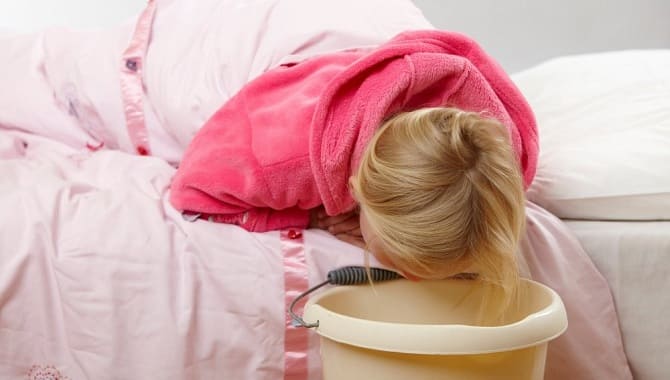
An increase in the level of acetone bodies is accompanied by intoxication. As a result, the functioning of the central nervous system is disrupted and the vomiting centers are irritated. Therefore, the child has no appetite and does not stop vomiting.
About prevention
A child has stress - sweet, active games - sweet, physical activity - sweet, cold - sweet, high temperature - sweet. It is important not to feed with sweets, which can lead to obesity, namely, not to allow all glucose and very small volumes of glycogen to be consumed; if this happens, the process of synthesis of acetone bodies (acetone production) will inevitably start.
If the first manifestation of acetone in a child occurred after the age of 4 years or periodically continues after 7 years, this is a reason for an in-depth medical examination; it should not be like this!
Why are high levels of ketones in urine dangerous?
The accumulation of acetone in the body is fraught with acetone syndrome, which manifests itself:
- lacrimation;
- feverish condition;
- tachycardia;
- persistent vomiting;
- severe dehydration;
- sleep disturbance;
- neurological disorders;
- arrhythmia.
If the problem is ignored, the liver increases in size (hepatomegaly). Patients with severe acetone syndrome exhibit meningeal symptoms - involuntary flexion of the limbs, tension in the neck muscles.
What tests reveal an increase in acetone in children?
Ketone bodies are determined by the results of a general urine test. The doctor prescribes tests when a child detects characteristic symptoms of acetonuria - a specific odor from the mouth, constant vomiting, decreased urine output, pale skin.
Laboratory research
Acetone in a child is determined according to OAM data. The key purpose of the test is to detect the amount of ketone antibodies in urine. To eliminate errors in the results, preparations for diagnosis are made 2 days before the biomaterial is submitted to the laboratory.
Preparation for OAM:
- 2 days before the study, exclude fatty and coloring foods from the diet;
- refuse hormonal medications and dietary supplements;
- Avoid psycho-emotional stress and physical exertion.
When collecting urine, the following rules must be taken into account:
- Only morning urine collected after waking up is used as a biomaterial;
- before collecting biomaterial, the genitals are washed with neutral soap;
- the first portion of urine (40 ml) is passed, and the middle portion (60-100 ml) is collected in a plastic container.
The container for collecting biomaterial should not touch the skin.
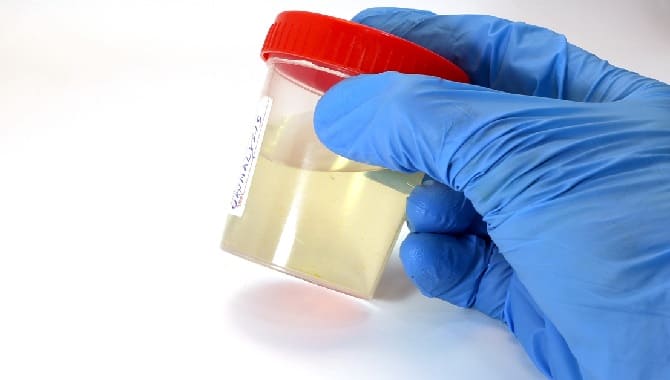
The collected liquid is transferred to the laboratory within 1-2 hours after collection.
To determine the cause of acetonuria, additional studies are prescribed:
- clinical blood test;
- blood test for glucose;
- Ultrasound of the urinary system;
- CT scan of the brain.
Based on the diagnostic results, the doctor distinguishes the disease from meningitis, intestinal infections, and cerebral edema.
Home test for acetonuria
To check the acetone content in a child’s body, it is enough to purchase a test strip at the pharmacy. It is impregnated with a reagent that changes color upon contact with ketone bodies. The degree of acetonuria is determined according to the scale:
- up to 0.5 mmol/l – absent;
- 5 mmol/l – mild;
- no more than 4.0 mmol/l – average;
- 10 mmol/l – severe.
If there is a lot of acetone, you need to make an appointment with your pediatrician. Doctors advise using indicator strips at home to monitor the effectiveness of treatment.
Notes from a laboratory assistant. Acetone syndrome in children
Authors : Kuznyak Irina
This topic evokes a lot of emotions in me. Firstly, a strong desire to help such special children, and secondly, an even stronger desire to tell them that this is not a problem at all if you initially understand the reasons for its occurrence and prevent them.
So, let's start with the basics: ketone bodies (or acetone) can appear in the urine if a person has diabetes, if there has been vomiting and/or diarrhea, that is, there is pathological loss of fluid, if one is fasting. This process has certain reasons, more about which you can read on the Internet or textbooks of pathological physiology.
I would like to talk about acetone in the urine of children, which appears literally “out of the blue.” Its cause is neuro-arthritic diathesis, that is, a tendency to ketonuria when eating certain foods and the presence of provoking factors. I will list later what should not be given to children under five years of age (all without exception), but the principle is this: almost everything dairy and vegetable is allowed.
The first manifestations of such acetone syndrome appear in a child between the ages of one and a half to two years (if by the age of three you have not learned what an acetone test is, then most likely your child is not one of these “lucky ones”). The first symptoms of acetone syndrome: headache, abdominal pain, then lethargy, then low-grade fever (against the background of normal blood and urine tests, since acetone in the urine will not appear in these children immediately, but somewhere on the 4-5th day such symptoms if appropriate measures are not taken and you continue to stuff yourself with “forbidden” products). And, for example, children with an intestinal infection will have ketonuria (++++) the very next morning after repeated vomiting.
Provoking factors for the appearance of acetone syndrome can be: 1) viral infection, 2) stress (I personally know several cases after tooth extraction at 2–3 years of age), 3) prohibited food eaten in large quantities, 4) refusal to drink or liquid food , 5) an increased gag reflex (which children, as a rule, outgrow by the age of 6–7 years) - for example, when such a child falls asleep with a normal runny nose, then after half an hour begins to cough (due to the fact that the muscles of the pharynx and the back wall have relaxed what was in the nose and adenoids flowed into the lower respiratory tract) and it comes to vomiting, respectively, each time he additionally loses electrolytes.
Regarding adenoiditis, I want to say that you need to let the child recover completely after each episode of a cold, because... The lymphoid tissue, once increased, then decreases quite slowly, and if the child falls ill again, then, without having time to return to its previous state, the adenoids increase even more. It is also necessary to take into account that children aged 2–5 years get sick more often, because... forms immunity for life, and it will be complete only if the child overcomes the disease with the formation of his own antibodies, and not with the help of an antibiotic, so it is important to be treated according to a blood test and swallow the antibiotic only when there is an indication, and parents should not just recover Send the baby straight away to a children's group and give him two to three weeks to get stronger. But I’ve already deviated completely from the topic.
I would also like to add that these children have a tendency to quite serious diseases that will appear when they grow up if certain measures are not taken in childhood (diabetes mellitus, gout).
So, I talked about the symptoms of acetonemic syndrome (confirmation of which will be a positive test for acetone) and provoking factors. Now the most important thing is what you shouldn’t give babies to eat and what to do if the test strip gives a disappointing result.
Children should not be given:
1) broth-based soups (already cooked meat can be added to vegetable soup, since what comes out of boiling meat or bones into water, to put it mildly, is not healthy), and, accordingly, such a “boiled” dish, as jellied meat (believe me, some parents give it to their children); and during ketonuria, meat is completely excluded from the diet;
2) meat of young animals - for example, veal - the main and favorite “representative” of children’s soups and steamed cutlets;
3) by-products (entrails) - here the main representative, of course, is liver, pates made from it, bird hearts, navels, etc.;
4) everything that contains cocoa - chocolate, sweets and breakfast cereals;
5) cheap ice cream (real ice cream is fine);
6) citrus fruits and ready-made fruit juices during an exacerbation.
What to do if you suspect or already know that “this” has begun? First, buy ACETONE-TEST at the pharmacy.
They are different, you just need to read on the label how to store the test strips (cheap ones, after opening, will only correctly show the month, so immediately write on the bottle the date you opened, so that the test strips do not mislead you six months later). Acetone in urine is checked as follows: hold the indicator zone of the strip in the urine for two or three seconds (no more!), take it out and wait - after three minutes it should not change color to pink and all shades of blue-violet, but remain colorless or yellow (colors urine). Check your urine for three days (if you measured the norm the first time), if you notice any of the symptoms listed above, and do this several times a day (there are still plenty of strips in the jar). Because often, when I ask whether acetone has been checked or not, the answer is: “We definitely don’t have it, since there is no smell of acetone at all!” And what a surprise among parents after this is the purple strip of the acetone test in this same child, from whom “there is no smell of acetone”... Remember: the child’s acetone should not be sniffed, but checked with test strips in the urine.
If the test strip turns pink or purple, tell your doctor. Follow a strict diet, excluding the above. Force him to drink liquid (you need to fight for every sip, and not say “he doesn’t want to drink”) - dried fruit compote, still mineral water, and simply purified water, and ready-made electrolyte powders for preparing solutions (Rehydron, Humana- electrolyte), but most of them refuse to drink after the fifth sip, so give what you are used to drinking.
The volume of liquid drunk is especially important, not its composition. For example, a two-year-old child in this state must drink at least 1.5 liters per day for this drinking to have an effect. A little sugar won't hurt - it will also be food, because... One of the symptoms of acetone syndrome is refusal to eat (it’s like a vicious circle). It is almost always very difficult to get a child to drink; he flatly refuses to drink, and large volumes of liquid drunk can additionally provoke vomiting. You can talk to your doctor about prescribing antiemetic medications. But drinking it depends only on you - give it a sip (or a teaspoon), but often - every 5 minutes, gradually increasing the volume - first two sips, after four hours - 3 sips.
You also need a sorbent (smecta, atoxil, enterosgel), but remember that it can aggravate constipation, so make sure you have regular bowel movements (if necessary, do a soda, room temperature (NOT warm!!) enema, which, by the way, is also indicated for treatment acetonemic syndrome). You can ask your doctor for dosages of medications.
Well, if you still can’t cope with the desoldering on your own within 24 hours, it may end up with an IV in the hospital.
However, I hasten to console you - with some persistence, this problem can be completely solved at home, and most importantly, as a rule, children “outgrow” it by the age of seven.
published 07/28/2017 00:00 updated 05/14/2018 - Nutrition, vitamins, Treatment methods, Emergency care
How to reduce ketone levels
For moderate acetonuria, hospitalization is not required. The treatment regimen is determined by the doctor taking into account the OAM data. The main goals of treatment include:
- reducing the amount of acetone in the body;
- restoration of carbohydrate and lipid metabolism;
- normalization of liver functions.
To prevent acetone syndrome, diet, drug therapy and physiotherapy are prescribed.
Colon lavage
To cure a child, it is necessary to reduce the acetone content in the body. Indications for the use of cleansing enemas are:
- vomit;
- loose stools;
- weakness;
- lack of appetite;
- elevated temperature.
Features of performing an enema:
- sodium bicarbonate solution is used as a washing liquid;
- before administration, the tip of the enema or bulb is lubricated with Vaseline;
- the rubber tip is inserted into the anus to a depth of 3.5-5 cm;
- 150-500 ml of liquid is injected into the rectum (the volume depends on the age of the child);
- Without opening the enema, the tip is carefully removed from the anus.

The procedure is performed once a day, but only on the recommendation of a pediatrician.
Frequent drinking
Treatment of acetone in children at home requires compliance with the drinking regime. To restore water and electrolyte balance and prevent dehydration, use the following as a drink:
- weak tea with honey or sugar;
- fruit compotes;
- herbal decoctions.
If the child is vomiting, they give powders with electrolytes and carbohydrates - Regidron, Gidrovit, Orsol, Electral. To restore liver function, it is recommended to give your baby alkaline mineral water.
Diet
Diet therapy is one of the most effective methods of preventing acetone syndrome in a child. To compensate for the lack of glucose, easily digestible carbohydrates are introduced into the diet:
- berries;
- milk;
- yogurt;
- dried fruits;
- vegetables;
- muesli;
- honey;
- watermelon;
- cottage cheese;
- fresh fruits;
- pancakes.
The consumption of foods with protein components, lipids and amino acids is limited. During treatment the following are excluded from the menu:
- fish;
- meat broths;
- smoked meats;
- fast food;
- offal;
- fat meat.
If a baby has acetonuria, it is necessary to increase the frequency of breastfeeding. If the baby is bottle-fed, use anti-reflux formulas with a high glucose content.
Medicines and enterosorbents
Drug therapy is aimed at eliminating intoxication and liver dysfunction. For acetonuria, the following groups of drugs are used:
- antiemetics (Domperidone, Cerucal) – eliminate nausea and vomiting;
- sedatives (Glycine, Atomoxetine) – have a calming effect on the nervous system, reducing anxiety and irritability;
- antispasmodics (Drospa forte, No-shpa) - relieve cramping pain in the abdomen.
Children with severe intoxication are prescribed infusion therapy. It involves intravenous administration of saline preparations and glucose.
To improve the condition of the liver, herbal hepatoprotectors are used - Hofitol, Artichol, Holosas, etc. For symptoms of hypovitaminosis, multivitamin products are recommended - Multivit, Supradin Kids, Vitrum, Pikovit, Aevit. To quickly remove toxins, sorbents are used - Polysorb Polyphepan, Filtrum, Enterosgel. Drinking alkaline water speeds up the elimination of toxins in the urine.
What should you feed your child?
Doctor Komarovsky - what should you give a child with acetonemia?
If acetone has already shown itself, then you shouldn’t even think about feeding the child by force. To digest food, the body requires energy, which means fats will be broken down and acetone bodies will be formed in even larger quantities. The child first needs to be given drinks, sweet water, or ideally a concentrated glucose solution, which can be bought at any pharmacy.
If you manage to give a glucose-containing liquid, that’s good, after a while you can start giving fruit. Ideal - raisins, fresh grapes, dried apricots, prunes, peaches, bananas, apples, sweets - sweets, chocolate, jam, etc. If there are improvements - porridge and any foods high in carbohydrates. This is the acetone diet for children.
Return to content
Until what age can acetone levels increase?
An excess of acetone in the blood serum occurs in 17-20% of young children. According to statistics, acetonuria first appears at 2-3 years of age. In children 6-7 years old, the concentration of ketone bodies increases sharply, which is associated with changes in the functioning of the gastrointestinal tract.
By puberty - 11-13 years - signs of acetonuria disappear in most children. If the level of acetone increases slightly, this indicates a metabolic disorder due to poor nutrition.

Fluctuations in the amount of ketones in infants in 90% of cases are due to insufficient nutrition.
Table of interpretation of the results of a urine test for ketone bodies in a child
| Meaning | What does it mean |
| — | negative, normal |
| + | weakly positive |
| ++/+++ | positive |
| ++++ | strongly positive, hospitalization required |
Keto tests are also available in the form of indicator strips, which change color when in contact with urine. The approximate content of ketones in the child’s urine is indicated next to each division. When you don't have test strips on hand, you can use ammonia. A few drops of the solution are added to the container with the child’s urine.
A bright scarlet color means an increase in ketone bodies in the child’s urine.
There are rare cases where rapid testing erroneously gives a negative result. You should contact your pediatrician and undergo additional examination.
Prevention
To prevent an increase in the amount of acetone in the urine in children, you should:
- balance the diet;
- do not feed your baby fast food;
- sign up for moderate exercise sports or dancing;
- observe drinking regime;
- walk in the fresh air more often;
- promptly treat metabolic diseases (obesity, diabetes).
Children with acetone syndrome need to undergo a course of vitamin therapy twice a year, take hepatoprotectors and sedatives. It is recommended to periodically determine the level of ketone bodies with a test strip. A child with diabetes should be registered with an endocrinologist. Timely detection and treatment of diseases prevents dangerous complications.
